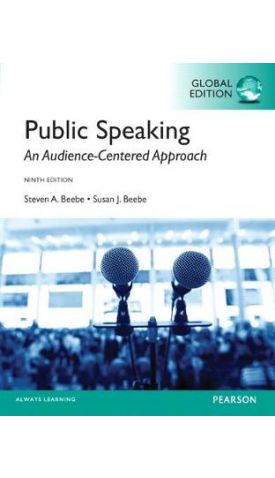אנו משתמשים ב-Cookies כדי לשפר את החוויה שלך. כדי לקיים ההנחיה החדשה של e-Privacy, עלינו לבקש את הסכמתך להגדיר את ה-Cookies. קבלת מידע נוסף.
509.00 ₪
Beebe: Public Speaking: An Audience-Centered Approach, Global Edition
509.00 ₪
ISBN13
9781292018393
יצא לאור ב
Harlow
מהדורה
9th edition
זמן אספקה
21 ימי עסקים
עמודים
IE
פורמט
Paperback / softback
תאריך יציאה לאור
15 במאי 2014
מחליף את פריט
9781292025247
An audience-centered approach to public speaking
Public Speaking: An Audience-Centered Approach brings theory and practice together. Its distinctive and popular approach emphasizes the importance of analyzing and considering the audience at every point in the speech making process. This model of public speaking is the foundation of the text, and it guides students through the step-by-step process of public speaking, focusing their attention on the dynamics of diverse audiences, and narrowing the gap between the classroom and the real world.
| מהדורה | 9th edition |
|---|---|
| עמודים | IE |
| מחליף את פריט | 9781292025247 |
| פורמט | Paperback / softback |
| ISBN10 | 1292018399 |
| יצא לאור ב | Harlow |
| תאריך יציאה לאור | 15 במאי 2014 |
| תוכן עניינים | In this Section: 1. Brief Table of Contents 2. Full Table of Contents 1. Brief Table of Contents Chapter 1: Speaking with Confidence Chapter 2: Presenting Your First Speech Chapter 3: Speaking Freely and Ethically Chapter 4: Listening to Speeches Chapter 5: Analyzing Your Audience Chapter 6: Developing Your Speech Chapter 7: Gathering and Using Supporting Material Chapter 8: Organizing and Outlining Your Speech Chapter 9: Introducing and Concluding Your Speech Chapter 10: Using Words Well: Speaker Language and Style Chapter 11: Delivering Your Speech Chapter 12: Using Presentation Aids Chapter 13: Speaking to Inform Chapter 14: Understanding Principles of Persuasive Speaking Chapter 15: Using Persuasive Strategies Chapter 16: Speaking for Special Occasions and Purposes Appendix A: Speaking in Small Groups Appendix B: Speeches for Analysis and Discussion 2. Full Table of Contents Chapter 1: Speaking with Confidence What is Public Speaking? Why Study Public Speaking? The Communication Process The Rich Heritage of Public Speaking Improving Your Confidence as a Speaker Chapter 2: Presenting Your First Speech Consider Your Audience Select and Narrow Your Topic Determine Your Purpose Develop Your Central Idea Generate the Main Ideas Gather Supporting Material Organize Your Speech Rehearse Your Speech Deliver Your Speech Chapter 3: Speaking Freely and Ethically Speaking Freely Speaking Ethically Chapter 4: Listening to Speeches Overcoming Barriers to Effective Listening How to Become a Better Listener Improving Listening and Critical Thinking Skills Analyzing and Evaluating Speeches Chapter 5: Analyzing Your Audience Gathering Information about Your Audience Analyzing Information about Your Audience Adapting to Your Audience Analyzing Your Audience before You Speak Adapting to Your Audience as You Speak Analyzing Your Audience after You Speak Chapter 6: Developing Your Speech Select and Narrow Your Topic Determine Your Purpose Develop Your Central Idea Generate and Preview Your Main Ideas Meanwhile, Back at the Computer . . . Chapter 7: Gathering and Using Supporting Material Sources of Supporting Material Research Strategies Types of Supporting Material The Best Supporting Material Chapter 8: Organizing and Outlining Your Speech Organizing Your Main Ideas Integrating Your Supporting Material Organizing Your Speech for the Ears of Others: Signposting Outlining Your Speech Chapter 9: Introducing and Concluding Your Speech Purposes of Introductions Effective Introductions Purposes of Conclusions Effective Conclusions Chapter 10: Using Words Well: Speaker Language and Style Using Words Effectively Adapting Your Language Style to Diverse Listeners Crafting Memorable Word Structures Chapter 11: Delivering Your Speech The Power of Speech Delivery Methods of Delivery Characteristics of Effective Delivery Audience Diversity and Delivery Rehearsing Your Speech: Some Final Tips Delivering Your Speech Responding to Questions Chapter 12: Using Presentation Aids The Value of Presentation Aids Types of Presentation Aids Guidelines for Developing Presentation Aids Guidelines for Using Presentation Aids Chapter 13: Speaking to Inform Types of Informative Speeches Strategies to Enhance Audience Understanding Strategies to Maintain Audience Interest Strategies to Enhance Audience Recall Developing an Audience-Centered Informative Speech Chapter 14: Understanding Principles of Persuasive Speaking The Goals of Persuasion How Persuasion Works How to Motivate Listeners How to Develop Your Audience-Centered Persuasive Speech Chapter 15: Using Persuasive Strategies Enhancing Your Credibility Using Logic and Evidence to Persuade Using Emotion to Persuade Strategies for Adapting Ideas to People and People to Ideas Strategies for Organizing Persuasive Messages Chapter 16: Speaking for Special Occasions and Purposes Public Speaking in the Workplace Ceremonial Speaking After-Dinner Speaking: Using Humor Effectively Appendix A: Speaking in Small Groups Solving Problems in Groups and Teams Participating in Small Groups Leading Small Groups Appendix B: Speeches for Analysis and Discussion I Have a Dream, Martin Luther King Jr. 2013 Inaugural Address, Barack Obama Duke University Commencement Address, Melinda Gates You're Not Special, David McCullough, Jr. Elvis, Angelitta Armijo |
| זמן אספקה | 21 ימי עסקים |



Login and Registration Form